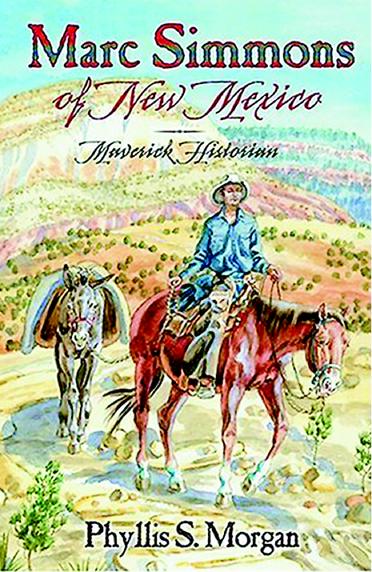But while Simmons’ work has secured him his own place in New Mexico history, his life is equally notable. Not only does Simmons live off the grid near Cerrillos, he continues to do all his writing on a manual typewriter.
Retired librarian Phyllis S. Morgan is the first to catalog that life for us in the first quarter of Marc Simmons of New Mexico. The second quarter provides an all-too-brief sampling of Simmons’ oeuvre. The rest is an extensive and exhaustive bibliography. It numbers an amazing 3,261 entries, or, as historian Mark L. Gardner notes in his foreword, four feet of books, pamphlets, articles and forewords of Simmons’ own.
As Simmons himself points out, “Here in New Mexico, history lies close to the surface, highly visible and accessible.” Yet this visibility and accessibility can be deceptive. What we see on first, or even second, glance is not necessarily the real story. Simmons’ most lasting legacy is the pursuit of that real story and a willingness to rewrite even his own histories when it turns out a fact he thought he got right the first time wasn’t as accurate as it had appeared on the surface.
One such instance occurred when Simmons wrote about the 1862 Civil War Battle of Valverde near Fort Craig. Using the official battle report as his primary source, Simmons had written that abandonment by the battle’s Hispanic volunteers led directly to a Confederate victory. This information became the standard used in history textbooks.
In a May 31, 2003 “Trail Dust” column in the Santa Fe New Mexican, Simmons outlines what happened after one reader saw this statement in the El Paso Times. “In a blistering letter, Herminia C. Gonzales disputed it. The First Regiment of New Mexico Volunteers, placed in the center of the Union line, had held like a rock, she claimed. As firm evidence she had a thick memoir in manuscript of her great uncle, an officer in that regiment.”
Simmons did some checking and found an account corroborating Mrs. Gonzales’ assertion. Then, in his own words, he did “a follow-up column that provided the volunteers with some vindication. Gonzales wrote again, saying, ‘I appreciate the fact that you are finally writing about the Valverde battle like it was.'”
Marc Simmons of New Mexico is designed for people who already have amassed a substantial Marc Simmons collection. This isn’t the book to read if you’re new to his work. The out-of-print Albuquerque: A Narrative History is highly recommended, as are the more readily available New Mexico: An Interpretive History and Coronado’s Land (both UNM Press). But, best of all, Simmons continues to write his columns for the New Mexican and Santa Fe, Always Online (www.sfaol.com). Subscribe and get your weekly dose of Simmons. That’s my prescription.









